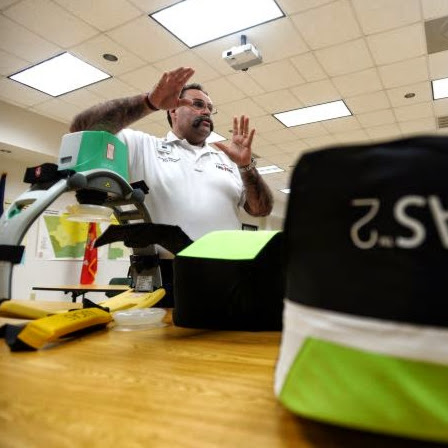Robert Jeffrey Simonson
age ~66
from Boynton Beach, FL
- Also known as:
-
- Robert J Simonson
- Rob J Simonson
- Jeffrey R Simonson
- Bob J Simonson
- Franca Simonson
- Robert Simpson
- Robert Simoson
- Phone and address:
-
1273 NW 11Th St, Boynton Beach, FL 33426
(561)7398041
Robert Simonson Phones & Addresses
- 1273 NW 11Th St, Boynton Beach, FL 33426 • (561)7398041
- Fort Pierce, FL
- Fort Lauderdale, FL
- Clifton, TN
- Palm Beach Gardens, FL
- Boca Raton, FL
Work
-
Company:Bright medical instruments
-
Address:4120 Oak Cir, Boca Raton, FL 33431
-
Phones:(561)6208100
-
Position:Owner
-
Industries:Surgical and Medical Instruments and Apparatus
Us Patents
-
Non Cannulated Dilators
view source -
US Patent:6916330, Jul 12, 2005
-
Filed:Oct 30, 2001
-
Appl. No.:10/024221
-
Inventors:Robert E. Simonson - Boca Raton FL, US
-
Assignee:DePuy Spine, Inc. - Raynham MA
-
International Classification:A61M029/00
-
US Classification:606191
-
Abstract:A non-cannulated dilator that is designed with a rigid elongated solid body and with a judiciously configured tip is utilized as the first dilator of a series of dilators which are inserted into the body of a patient for minimally invasive spinal surgery and is made from a solid elongated body, that could be round, ovoid or other cross sectional configuration whose diameter is greater than one and a half (1) millimeter, and that includes a tool engaging end portion at the proximal end is sufficiently rigid so as not to bend and has a pointed shaped insertion end portion at the distal end with the point of the pointed end being discreetly blunted and utilized in a surgical procedure as a replacement of the typical guide wire and is characterized as providing a “feel” to the surgeon as it penetrates through the tissue and muscle of the patient as it proceeds toward the target.
-
Configured And Sized Cannula
view source -
US Patent:7008431, Mar 7, 2006
-
Filed:Oct 30, 2001
-
Appl. No.:10/021809
-
Inventors:Robert E. Simonson - Boca Raton FL, US
-
Assignee:DePuy Spine, Inc. - Raynham MA
-
International Classification:A61F 5/00
A61F 17/58 -
US Classification:606 86, 606 99
-
Abstract:A dilator retractor and the dilators that are used for minimally invasive spinal surgery or other surgery are configured to accommodate the anatomical structure of the patient as by configuring the cross sectional area in an elliptical shape, or by forming a funnel configuration with the wider end at the proximate end. In some embodiments the distal end is contoured to also accommodate the anatomical structure of the patient so that a cylindrically shaped, funnel shaped, ovoid shaped dilator retractor can be sloped or tunneled to accommodate the bone structure of the patient or provide access for implants. The dilator retractor is made with different lengths to accommodate the depth of the cavity formed by the dilators.
-
Handle For Medical Instruments
view source -
US Patent:D553738, Oct 23, 2007
-
Filed:Mar 29, 2004
-
Appl. No.:29/202255
-
Inventors:Robert E. Simonson - Boca Raton FL, US
-
International Classification:2402
-
US Classification:D24133, D8300
-
Instruments And Methods For Minimally Invasive Spine Surgery
view source -
US Patent:7824410, Nov 2, 2010
-
Filed:Aug 10, 2004
-
Appl. No.:10/914983
-
Inventors:Robert E Simonson - Boca Raton FL, US
Timothy Allen Beardsley - Kingston MA, US
Douglas Scott Bireley - Barrington RI, US -
Assignee:DepuY Spine, Inc. - Raynham MA
-
International Classification:A61B 17/58
-
US Classification:606 86A, 606190, 600203
-
Abstract:A minimally invasive surgical method includes inserting a first port that defines a first pathway to a first vertebra, advancing a first anchor through the first port to the first vertebra, inserting a second port that defines a second pathway to a second vertebra, advancing a second anchor through the second port to the second vertebra, positioning a first end of a fixation element in the first port, and advancing the first end of the fixation element subcutaneously through an opening in the first port and an opening in second port to the second anchor. A surgical access port includes a proximal end, a distal end, and a sidewall defining a lumen extending from the proximal end to the distal end. The port may include a first opening formed in the sidewall that defines a passageway for medical hardware from the lumen to external to the port.
-
Cannula And Sizing Insertion Method
view source -
US Patent:RE42525, Jul 5, 2011
-
Filed:Jun 10, 2002
-
Appl. No.:10/165991
-
Inventors:Robert E. Simonson - Boca Raton FL, US
-
Assignee:DePuy Spine, Inc. - Raynham MA
-
International Classification:A61M 5/00
-
US Classification:604117, 60416401, 604500, 606108
-
Abstract:A relatively inexpensive cannula is sized by including indica on a cannulated dilator that is used to measure the depth of a body cavity, and in one embodiment with the use of a cuttable fixture inserted into an initially enlarged dilator retractor made from a cuttable material the excess of the dilator retractor is snipped by a commercial cutter. A tool engaging the end of the cannulated dilator provides leverage on the cannulated dilator for rotation as it is forced into the body cavity, a pusher tool provides leverage on the dilator retractor for inserting the dilator retractor into the body cavity. A clamp that fits the top of the dilator retractor serves to support the dilator retractor through an arm to a rigid structure. In an alternate embodiment one of a series of sized dilator retractors are selected commensurate with the measurement attained by the scaled cannulated dilator.
-
Configured And Sized Cannula
view source -
US Patent:8192437, Jun 5, 2012
-
Filed:Jan 6, 2005
-
Appl. No.:11/030218
-
Inventors:Robert E. Simonson - Boca Raton FL, US
-
Assignee:DePuy Spine, Inc. - Raynham MA
-
International Classification:A61B 17/88
-
US Classification:606 86A, 606279
-
Abstract:A dilator retractor and the dilators that are used for minimally invasive spinal surgery or other surgery are configured to accommodate the anatomical structure of the patient as by configuring the cross sectional area in an elliptical shape, or by forming a funnel configuration with the wider end at the proximate end. In some embodiments the distal end is contoured to also accommodate the anatomical structure of the patient so that a cylindrically shaped, funnel shaped, ovoid shaped dilator retractor can be sloped or tunneled to accommodate the bone structure of the patient or provide access for implants. The dilator retractor is made with different lengths to accommodate the depth of the cavity formed by the dilators.
-
Configured And Sized Cannula
view source -
US Patent:8235999, Aug 7, 2012
-
Filed:May 10, 2010
-
Appl. No.:12/776857
-
Inventors:Robert E. Simonson - Boca Raton FL, US
-
Assignee:DePuy Spine, Inc. - Raynham MA
-
International Classification:A61B 17/88
-
US Classification:606 86A, 606279
-
Abstract:A dilator retractor and the dilators that are used for minimally invasive spinal surgery or other surgery are configured to accommodate the anatomical structure of the patient as by configuring the cross sectional area in an elliptical shape, or by forming a funnel configuration with the wider end at the proximate end. In some embodiments the distal end is contoured to also accommodate the anatomical structure of the patient so that a cylindrically shaped, funnel shaped, ovoid shaped dilator retractor can be sloped or tunneled to accommodate the bone structure of the patient or provide access for implants. The dilator retractor is made with different lengths to accommodate the depth of the cavity formed by the dilators.
-
Configured And Sized Cannula
view source -
US Patent:8361151, Jan 29, 2013
-
Filed:Jun 14, 2012
-
Appl. No.:13/523033
-
Inventors:Robert E. Simonson - Boca Raton FL, US
-
Assignee:DePuy Spine, Inc. - Raynham MA
-
International Classification:A61F 2/44
-
US Classification:623 1711, 606 86 A, 606279
-
Abstract:A dilator retractor and the dilators that are used for minimally invasive spinal surgery or other surgery are configured to accommodate the anatomical structure of the patient as by configuring the cross sectional area in an elliptical shape, or by forming a funnel configuration with the wider end at the proximate end. In some embodiments the distal end is contoured to also accommodate the anatomical structure of the patient so that a cylindrically shaped, funnel shaped, ovoid shaped dilator retractor can be sloped or tunneled to accommodate the bone structure of the patient or provide access for implants. The dilator retractor is made with different lengths to accommodate the depth of the cavity formed by the dilators.
Isbn (Books And Publications)


Role of a Lifetime: Four Professional Actors and How They Built Their Careers
view sourceAuthor
Robert Simonson
ISBN #
0823078329
License Records
Robert Jeffrey Simonson
Address:
1273 NW 11 St, Boynton Beach, FL 33426
License #:
SL3364456 - Active
Category:
Real Estate
Issued Date:
Aug 19, 2016
Effective Date:
Aug 18, 2016
Expiration Date:
Mar 31, 2018
Type:
Sales Associate
Name / Title
Company / Classification
Phones & Addresses
Partner
Golden Rock Products Inc.
Natural Stone Suppliers. Landscaping Equipment Suppliers. Suppliers -Landscape Natural/Man-Made Materials
Natural Stone Suppliers. Landscaping Equipment Suppliers. Suppliers -Landscape Natural/Man-Made Materials
8086 Hwy. 95A, Kimberley, BC V1A 3L6
(250)3448999, (250)3444899
(250)3448999, (250)3444899
Owner
Bright Medical Instruments
Surgical and Medical Instruments and Apparatus
Surgical and Medical Instruments and Apparatus
4120 Oak Cir, Boca Raton, FL 33431
Website: brightmedical.org
Website: brightmedical.org
President
Bob's Design & Estate Jewelry, Inc
Jewelry Stores
Jewelry Stores
1273 NW 11 St, Boynton Beach, FL 33426
8221 W Glades Rd, Boca Raton, FL 33434
(561)8521441
8221 W Glades Rd, Boca Raton, FL 33434
(561)8521441
Owner
Bright Medical Instruments
Physicians & Surgeons Equip &
Physicians & Surgeons Equip &
4120 Oak Cir, Boca Raton, FL 33431
(561)6208100
(561)6208100
Partner
Golden Rock Products Inc
Natural Stone Suppliers · Landscaping Equipment Suppliers · Suppliers -Landscape Natural/Man-Made Materials
Natural Stone Suppliers · Landscaping Equipment Suppliers · Suppliers -Landscape Natural/Man-Made Materials
(250)3448999, (250)3444899
President, Director
The Maxline Group, Inc
834 NE 33 St, Boca Raton, FL 33431
350 Royal Palm Way, Palm Beach, FL 33480
515 N Flagler Dr, West Palm Beach, FL 33401
350 Royal Palm Way, Palm Beach, FL 33480
515 N Flagler Dr, West Palm Beach, FL 33401
Principal
Bright Group Inc
Business Services at Non-Commercial Site
Business Services at Non-Commercial Site
799 NE 71 St, Boca Raton, FL 33487
Bright Spine, LLC
Mfg Surgical/Medical Instruments
Mfg Surgical/Medical Instruments
799 NE 71 St, Boca Raton, FL 33487
Medicine Doctors

Robert B. Simonson
view sourceSpecialties:
Emergency Medicine
Work:
Texas Physician Resources
6451 Brentwood Stair Rd STE 200, Fort Worth, TX 76112
(817)4969700 (phone), (817)4969889 (fax)
6451 Brentwood Stair Rd STE 200, Fort Worth, TX 76112
(817)4969700 (phone), (817)4969889 (fax)
Education:
Medical School
University of North Texas College of Osteopathic Medicine
Graduated: 1981
University of North Texas College of Osteopathic Medicine
Graduated: 1981
Languages:
English
Spanish
Spanish
Description:
Dr. Simonson graduated from the University of North Texas College of Osteopathic Medicine in 1981. He works in Fort Worth, TX and specializes in Emergency Medicine. Dr. Simonson is affiliated with Methodist Charlton Medical Center.

Robert L. Simonson
view sourceSpecialties:
Orthopaedic Surgery
Work:
Premiere Orthopedics PA
75 Thomas Johnson Dr STE N, Frederick, MD 21702
(301)6630009 (phone), (301)6958633 (fax)
75 Thomas Johnson Dr STE N, Frederick, MD 21702
(301)6630009 (phone), (301)6958633 (fax)
Languages:
English
Spanish
Spanish
Description:
Mr. Simonson works in Frederick, MD and specializes in Orthopaedic Surgery. Mr. Simonson is affiliated with Howard County General Hospital.
Resumes

Robert Simonson
view sourceLocation:
United States

Robert Simonson
view sourceLocation:
United States

Tactical Aircraft Maintenance Journeyman At United States Air Force
view sourceLocation:
US Military Posts in Europe
Industry:
Defense & Space
Classmates

Robert Simonson
view sourceSchools:
Divide High School Nolan TX 1967-1971
Community:
Marcoleta Ashton, Larry Welch

Robert Simonson
view sourceSchools:
Clear Creek Amana High School Amana IA 1968-1972

Robert Simonson
view sourceSchools:
Montague Elementary School Mt. Morris MI 2000-2004
Community:
Lorna Almasy, Kristy Lawless

Robert Simonson
view sourceSchools:
Sheyenne High School Sheyenne ND 1965-1969
Community:
Rita Haman, Ben Rusness

Robert Simonson (Robert ...
view sourceSchools:
Swedesboro High School Swedesboro NJ 1946-1950
Community:
Frank Schoener, William Justice, Margaret Nolte, Douglas Clark, Marilyn Edelstein, Sonia Dilks, Alfred Schober, Fred Zayac, Raymond Hoffman, Raymond Jr, Darlene Krouse

Robert Simonson
view sourceSchools:
Amsdell Junior High School Hamburg NY 1974-1976
Community:
Stacy Cherniss

Robert Simonson
view sourceSchools:
Trego Community High School Wakeeney KS 1981-1985
Community:
Lisa Jamison, Carol Schreiner, Steven Bellairs, Steven Jackson, Ramona Oelke, Josh Carson, David Jones, Stephen Parsons, Kami Martin

Robert Simonson | Haverfo...
view source
Robert Simonson
view source
Robert Simonson
view source
Robert Simonson
view source
Robert Simonson
view source
Robert Simonson
view source
Robert Simonson
view source
Robert Simonson
view source
Robert Simonson
view sourceYoutube
Myspace
Googleplus

Robert Simonson

Robert Simonson

Robert Simonson

Robert Simonson

Robert Simonson

Robert Simonson

Robert Simonson
Work:
Tristatepainting - Painter
Education:
Ben f north high
About:
Went to north high grew up on oak st have three brothers
Tagline:
48yrs old two boys single
Bragging Rights:
Two blonde boys grad year early

Robert Simonson
Education:
North Carolina Central University
Tagline:
Life is just
Flickr
News

The Japanese-Style Bar Is Booming in New York. Each Tells a Different Story.
view source- ast Village in 1993a time when New York Citys bar scene was awash with Cosmopolitans, Appletinis and Lychee Martinishe created a space that represented Manhattans first taste of the Tokyo style of cocktail bar: all formality, intimacy and meticulous service, wrote Robert Simonson in this 24-ye
- Date: Aug 12, 2024
- Category: Technology
- Source: Google
Get Report for Robert Jeffrey Simonson from Boynton Beach, FL, age ~66















